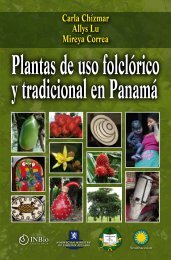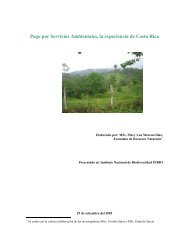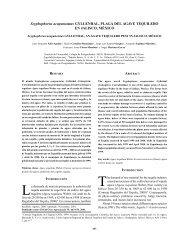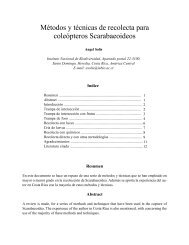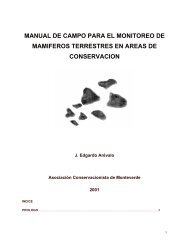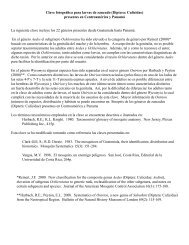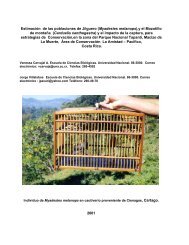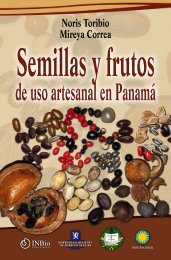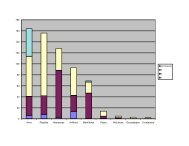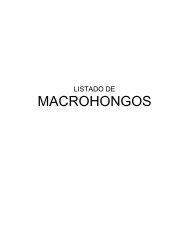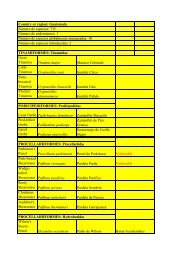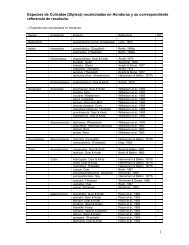the genus Coccocarpia (Peltigerales: Coccocarpiaceae) - Instituto ...
the genus Coccocarpia (Peltigerales: Coccocarpiaceae) - Instituto ...
the genus Coccocarpia (Peltigerales: Coccocarpiaceae) - Instituto ...
Create successful ePaper yourself
Turn your PDF publications into a flip-book with our unique Google optimized e-Paper software.
Lichenological Contributions in Honour of David Galloway.<br />
I. Kärnefelt (ed.): Biblio<strong>the</strong>ca Lichenologica 95:429–457.<br />
J. Cramer in der Gebrüder Bornträger Verlagsbuchhandlung, Berlin · Stuttgart, 2007.<br />
A first assessment of <strong>the</strong> TICOLICHEN biodiversity inventory<br />
in Costa Rica: <strong>the</strong> <strong>genus</strong> <strong>Coccocarpia</strong><br />
(<strong>Peltigerales</strong>: <strong>Coccocarpia</strong>ceae)<br />
Robert LÜCKING 1 , André APTROOT 2 , José Luis CHAVES 3 , Harrie J. M. SIPMAN 4<br />
& Loengrin UMAÑA 3<br />
1 Department of Botany, The Field Museum, 1400 South Lake Shore Drive, Chicago, IL 60605-2496, USA;<br />
email: rlucking@fieldmuseum.org<br />
2 ABL Herbarium, G.v.d. Veenstraat 107, NL-3762 XK Soest, The Ne<strong>the</strong>rlands;<br />
email: andreaptroot@wanadoo.nl<br />
3Laboratorio de Hongos, <strong>Instituto</strong> Nacional de Biodiversidad (INBio), Apdo. 22-3100, Santo Domingo<br />
de Heredia, Costa Rica; email: jchaves@inbio.ac.cr; lumana@inbio.ac.cr<br />
4Botanisches Museum Berlin Dahlem, Königin-Luise-Strasse 6-8, D-14191 Berlin, Germany;<br />
email: h.sipman@bgbm.org<br />
Abstract: The <strong>genus</strong> <strong>Coccocarpia</strong> is treated as part of <strong>the</strong> ongoing TICOLICHEN biodiversity inventory in<br />
Costa Rica, including a thorough revision of all <strong>the</strong> material reported by Dodge and held at <strong>the</strong> Farlow<br />
Herbarium (FH). Eighteen species are distinguished, among which four taxa are described as new:<br />
<strong>Coccocarpia</strong> gallaicoi Lücking, Chaves & Umaña (with <strong>the</strong> non-isidiate counterpart C. aff. gallaicoi), C.<br />
microphyllina Lücking & Aptroot (phyllidiate relative of C. epiphylla), C. neglecta Aptroot & Lücking<br />
(differing from C. domingensis by its squamiform isidia), and C. prostrata Lücking, Aptroot & Sipman<br />
(related to C. stellata but with ascending, fruticulose secondary lobes). The name C. guimarana (Vain.)<br />
Swins. & Krog is reinstated for a species with narrow, isidiate lobes. Two fur<strong>the</strong>r, possibly undescribed<br />
species are tentatively identified as C. aff. gallaicoi Lücking, Chaves & Umaña and C. aff. imbricascens Nyl.<br />
Six taxa, viz. <strong>Coccocarpia</strong> adnata L. Arvidss., C. dissecta Swinsc. & Krog, C. epiphylla (Fée) Kremp., C.<br />
filiformis L. Arvidss., C. glaucina Kremp., and C. tenuissima Tuck., are reported for <strong>the</strong> first time from Costa<br />
Rica. <strong>Coccocarpia</strong> adnata and C. glaucina are also new records for <strong>the</strong> Neotropics, and C. filiformis is new to<br />
Central America. Analysis of <strong>the</strong> available material shows ecological differentiation between species:<br />
<strong>Coccocarpia</strong> erythroxyli and C. palmicola have a wide ecological amplitude, being found from (semi-) arid to<br />
perhumid situations and from sea level to <strong>the</strong> subparamo zone at 3500 m, while <strong>Coccocarpia</strong> dissecta is<br />
mostly a lowland species typical of (semi-)arid to humid climates. The o<strong>the</strong>r taxa are confined to humid<br />
climates; while C. guimarana, C. glaucina, C. neglecta, and C. tenuissima seem to prefer lowland to<br />
submontane zones, <strong>the</strong> remaining species are chiefly montane, with C. domingensis, C. filiformis, C. pellita<br />
and C. prostrata reaching <strong>the</strong> subparamo zone. <strong>Coccocarpia</strong> as a whole is most abundant and most diverse in<br />
humid to perhumid, lower montane to montane situations, and <strong>the</strong> species generally prefer semi-exposed to<br />
exposed (micro-)habitats.<br />
429
Introduction<br />
In 2002, we started TICOLICHEN, a project supported by <strong>the</strong> National Science Foundation<br />
(NSF) to unravel Costa Ricas tremendous lichen diversity (GÁMEZ et al. 1997; LÜCKING et<br />
al. 2004; CHAVES et al. 2004; LÜCKING 2005). The goals of this international collaboration<br />
between The Field Museum in Chicago, <strong>the</strong> <strong>Instituto</strong> Nacional de Biodiversidad (INBio) in<br />
Costa Rica, <strong>the</strong> Botanischer Garten & Botanisches Museum in Berlin, and various o<strong>the</strong>r<br />
institutions in <strong>the</strong> United States (University of Wisconsin-Madison, New York Botanical<br />
Garden), The Ne<strong>the</strong>rlands (Adviesbureau voor Bryologie en Lichenologie), and Austria<br />
(Karl-Franzens-Universität), are to enhance <strong>the</strong> taxonomic knowledge of tropical lichens at<br />
both <strong>the</strong> local and world-wide level, through a comprehensive, printed lichen biota of Costa<br />
Rica, tentatively scheduled for publication in 2008. Several genera and families have<br />
already been treated in individual assessments, in order to communicate improvements in<br />
our taxonomic understanding of tropical lichens (CHAVES et al. 2004; GRUBE et al. 2004;<br />
LÜCKING et al. 2006a, b; NELSEN et al. 2006; RIVAS PLATA et al. 2006).<br />
Here we present a preliminary treatment of <strong>Coccocarpia</strong> Pers., a <strong>genus</strong> of about 25,<br />
small-foliose, cyanophilic lichen species mainly found in <strong>the</strong> humid tropics, but with a few<br />
taxa extending into <strong>the</strong> nor<strong>the</strong>rn and sou<strong>the</strong>rn hemisphere. <strong>Coccocarpia</strong> forms <strong>the</strong> core<br />
<strong>genus</strong> of <strong>the</strong> <strong>Coccocarpia</strong>ceae, a small family of about five genera now confirmed to belong<br />
to suborder Collematineae within <strong>Peltigerales</strong>, toge<strong>the</strong>r with Collemataceae, Pannariaceae,<br />
and Placynthiaceae (MIADLIKOWSKA & LUTZONI 2004; MIADLIKOWSKA et al. 2006).<br />
<strong>Coccocarpia</strong> was first treated in a modern sense by SANTESSON (1952), HENSSEN (1963)<br />
and HENSSEN & JAHNS (1974) and eventually monographed more than 20 years ago by<br />
ARVIDSSON (1983). Since <strong>the</strong>n, remarkably few papers have been published with new<br />
discoveries. Only two new species were described, both from Venezuela (MARCANO et al.<br />
1995): <strong>Coccocarpia</strong> culatensis V. Marcano & A. Morales, related to C. epiphylla, and C.<br />
duidensis V. Marcano, Galiz & A. Morales, related to C. dissecta.<br />
An extensive treatment of <strong>Coccocarpia</strong> in Costa Rica was presented by DODGE (1933),<br />
who reported 11 names, four species and seven varieties, including <strong>the</strong> new species C.<br />
albida Dodge. Unfortunately, his treatment is completely untenable, since a revision of <strong>the</strong><br />
rich material in FH (75 specimens) revealed <strong>the</strong>se names to be a confusing mix of mostly<br />
C. erythroxyli, C. palmicola, and C. pellita, but also C. adnata, C. dissecta, and C.<br />
glaucina, and <strong>the</strong> overlooked new species, C. gallaicoi, described herein. During our<br />
TICOLICHEN survey, we identified 18 species of <strong>Coccocarpia</strong>, four of which could not be<br />
identified with any known species and which are here described as new, including <strong>the</strong> C.<br />
gallaicoi dedicated to David Galloway, and a fur<strong>the</strong>r one which it tentatively identified as<br />
C. aff. gallaicoi. We also present a key and an ecological analysis of <strong>the</strong> <strong>genus</strong> in Costa<br />
Rica.<br />
430
Material and Methods<br />
Specimens were mainly studied at The Field Museum (F) in Chicago, <strong>the</strong> <strong>Instituto</strong> Nacional<br />
de Biodiversidad (INBio) in Costa Rica, <strong>the</strong> Farlow Herbarium (FH) at Harvard University<br />
in Cambridge, Massachussetts, and <strong>the</strong> Botanischer Garten & Botanisches Museum in<br />
Berlin, Germany. At <strong>the</strong> Farlow Herbarium, we revised all <strong>the</strong> material of <strong>the</strong> <strong>genus</strong><br />
reported for Costa Rica by Dodge (1933). Thallus morphology was assessed using a<br />
LEICA MS5 stereo microscope, and thin hand sections of thalli and apo<strong>the</strong>cia were studied<br />
under a ZEISS Axioskop 2 compound microscope. Images were taken with a NIKON<br />
Coolpix 5400 digital camera through a ZEISS W-PI 10x/23 eyepiece directly attached to<br />
<strong>the</strong> stereo microscope.<br />
For <strong>the</strong> ecological analysis, we assessed environmental parameters for all studied<br />
collections when available, using three environmental gradients, based on HOLDRIDGE<br />
(1982) and LÜCKING (1995, 1997): (1) Precipitation regime (arid - semi-arid - subhumid -<br />
humid - perhumid); (2) altitude (lowland - colline - submontane - lower montane - montane<br />
- upper montane - subparamo); and (3) light exposure (fully shaded - shaded - intermediate<br />
- exposed - fully exposed). According to <strong>the</strong>ir range within each gradient, <strong>the</strong> species were<br />
ordinated within a two-dimensional grid, using precipitation regime and altitude as main<br />
axis and expressing light exposure by shades of black, grey, and white.<br />
The Species<br />
Our survey of recent and historical collections revealed a total of 18 taxa (Table 1) which<br />
are keyed out below. Nomenclature follows ARVIDSSON (1983) unless o<strong>the</strong>rwise stated; no<br />
nomenclatural references are given here for names already treated in that monograph.<br />
Many of <strong>the</strong> names reported earlier by MÜLLER ARGOVIENSIS (1892, 1894) and DODGE<br />
(1933) had already been placed into synonymy by ARVIDSSON (1983), and thorough<br />
revision of <strong>the</strong> material at FH and G was necessary to elucidate <strong>the</strong>ir correct identifications<br />
(Table 2).<br />
Judging from <strong>the</strong>ir thallus and apo<strong>the</strong>cial morphology, several of <strong>the</strong> taxa distinguished<br />
here can be considered primary versus secondary species (Table 3), and molecular<br />
phylogenetic analysis is required to see whe<strong>the</strong>r <strong>the</strong> species concepts hold in <strong>the</strong>se cases.<br />
Studies in o<strong>the</strong>r groups, such as <strong>the</strong> Physciaceae, have shown that in many cases, primary<br />
and secondary species form part of ei<strong>the</strong>r a single-species complex with variable dispersal<br />
strategy or several species which all may include both sexual and vegetative forms.<br />
431
Table 1. Species of <strong>Coccocarpia</strong> recorded for Costa Rica. Detailed collection data, including color images,<br />
can be retrieved online from The Field Museum's Botany Collections Database at<br />
http://emuweb.fieldmuseum.org/botany/search_crf.php.<br />
__________________________________________________________________________________<br />
<strong>Coccocarpia</strong> adnata L. Arvidss.<br />
<strong>Coccocarpia</strong> dissecta Swinsc. & Krog<br />
<strong>Coccocarpia</strong> domingensis Vain.<br />
<strong>Coccocarpia</strong> epiphylla (Fée) Kremp.<br />
<strong>Coccocarpia</strong> erythroxyli (Spreng.) Swinsc. & Krog<br />
<strong>Coccocarpia</strong> filiformis L. Arvidss.<br />
<strong>Coccocarpia</strong> gallaicoi Lücking, Chaves & Umaña sp. nov.<br />
<strong>Coccocarpia</strong> aff. gallaicoi Lücking, Chaves & Umaña<br />
<strong>Coccocarpia</strong> glaucina Kremp.<br />
<strong>Coccocarpia</strong> guimarana (Vain.) Swins. & Krog.<br />
<strong>Coccocarpia</strong> aff. imbricascens Nyl.<br />
<strong>Coccocarpia</strong> microphyllina Lücking & Aptroot sp. nov.<br />
<strong>Coccocarpia</strong> neglecta Aptroot & Lücking sp. nov.<br />
<strong>Coccocarpia</strong> palmicola (Spreng.) L. Arvidss. & D. Gall.<br />
<strong>Coccocarpia</strong> pellita (Ach.) Müll. Arg.<br />
<strong>Coccocarpia</strong> prostrata Lücking, Aptroot & Sipman sp. nov.<br />
<strong>Coccocarpia</strong> stellata Tuck.<br />
<strong>Coccocarpia</strong> tenuissima Müll. Arg.<br />
__________________________________________________________________________________<br />
The morphology and position of isidia and lobules plays an important role in distinguishing<br />
species of <strong>Coccocarpia</strong>. The distinction of isidia, phyllidia, lobules, and o<strong>the</strong>r similar<br />
structures, is not always clearcut in <strong>the</strong> literature (see discussion in ARVIDSSON 1983: 12),<br />
and we have here used a combination of morphological and functional definitions (Table<br />
4). The term "phyllidia" was originally introduced for flattened isidia, but in our opinion<br />
covers perfectly <strong>the</strong> marginal isidioid, strongly branched structures found, for example, in<br />
Sticta species (MCDONALD et al. 2003). The structures have <strong>the</strong> same color as <strong>the</strong> thallus<br />
(while true isidia in Sticta are usually darker) and do not seem to act as dispersal organs,<br />
but ra<strong>the</strong>r increase <strong>the</strong> thallus surface for enhanced gas exchange. So defined, phyllidia<br />
differ from both flattened isidia (in function) and accessory lobules (in <strong>the</strong> absence of<br />
rhizines). The new species <strong>Coccocarpia</strong> microphyllina is <strong>the</strong> first in <strong>the</strong> <strong>genus</strong> in which<br />
such phyllidia are found; all o<strong>the</strong>r species ei<strong>the</strong>r produce isidia in <strong>the</strong> strict sense or<br />
accessory lobules.<br />
Table 2. Revision of names in <strong>Coccocarpia</strong> published by DODGE (1933) for Costa Rica and on labels of<br />
specimens in FH, <strong>the</strong>ir current nomenclatural status, and taxonomic identification of <strong>the</strong> material (see also list<br />
of cited specimens under each taxon entry below). *names not published by Dodge (1933) but used on<br />
specimen labels, **superfluous new combinations published by DODGE (1933) of names already recombined<br />
432
previously by Vainio and Zahlbruckner, ***unpublished new combinations made by Dodge on specimen<br />
labels.<br />
Name Current name Correct identification<br />
albida Dodge palmicola palmicola (type), glaucina<br />
cronia (Tuck.) Vain. palmicola palmicola, pellita, dissecta<br />
var. furfuracea (Müll. Arg.) Vain.* pellita palmicola, erythroxyli<br />
var. granulosa (Müll. Arg.) Dodge** erythroxyli palmicola<br />
var. isidiophylla (Müll. Arg.) Dodge** palmicola palmicola, dissecta<br />
var. isidiosa (Müll. Arg.) Vain.* palmicola dissecta, palmicola, gallaicoi<br />
var. lividorufa (Meyen & Flotow) Dodge** pellita pellita, palmicola, erythroxyli<br />
var. prolificans (Malme) Dodge** pellita pellita<br />
elegans Müll. Arg. stellata stellata<br />
isidiophylla (Müll. Arg.) ined.*** palmicola palmicola, dissecta<br />
var. granulosa (Müll. Arg.) ined.*** palmicola palmicola, dissecta, glaucina<br />
var. prolificans (Müll. Arg.) ined.*** pellita pellita, palmicola<br />
pellita (Ach.) Müll. Arg. pellita pellita<br />
var. parmelioides (Hook.) Müll. Arg. erythroxyli erythroxyli, palmicola, glaucina<br />
var. pyrrhichocarpa Hue erythroxyli erythroxyli<br />
var. smaragdina (Pers.) Müll. Arg.* smaragdina erythroxyli<br />
var. strigosa Müll. Arg. erythroxyli erythroxyli, adnata<br />
tenuissima Müll. Arg.* tenuissima neglecta<br />
Table 3. Presumed primary and secondary species in <strong>the</strong> <strong>genus</strong> <strong>Coccocarpia</strong> in Costa Rica, separated by type<br />
of isidia present.<br />
Thallus type Primary species Secondary species<br />
cylindrical / flattened isidia squamiform isidia phyllidia<br />
broadly flabellate C. erythroxyli C. palmicola C. pellita<br />
linear dissected C. adnata C. dissecta<br />
squamulose C. aff. gallaicoi C. gallaicoi<br />
narrowly flabellate C. epiphylla C. microphyllina<br />
linear spaced C. stellata C. domingensis C. neglecta<br />
Table 4. Morphological and functional definitions used here for isidia, phyllidia, accessory lobules, and<br />
similar structures in <strong>the</strong> <strong>genus</strong> <strong>Coccocarpia</strong>.<br />
433
Structure Section Symmetry Position Orientation Rhizines Function Example<br />
isidia round radiately ± laminal vertical — dispersal palmicola<br />
(cylindrical)<br />
symmetrical<br />
isidia flattened bisymmetrical ± laminal oblique — dispersal domingensis<br />
(flattened) (± unbranched)<br />
isidia flattened dorsiventral ± laminal horizontal — dispersal pellita<br />
(squamiform) (± unbranched)<br />
phyllidia flattened dorsiventral ± marginal horizontal — ?surface microphyllina<br />
(± branched)<br />
increase<br />
accessory flattened dorsiventral ± marginal horizontal present ?surface several species<br />
lobules<br />
increase<br />
Key to <strong>the</strong> species of <strong>Coccocarpia</strong> in Costa Rica<br />
1 Cylindrical to flattened or squamiform isidia or phyllidia present or thallus ascendent to fruticulose ............2<br />
1 Isidia absent and thallus flattened-foliose ......................................................................................................12<br />
2 Thallus with richly branched phyllidia or secondary lobes or ascendent to fruticulose...................................3<br />
2 Thallus with cylindrical to flattened or squamiform isidia...............................................................................5<br />
3 Thallus fruticulose, lobes less than 0.1 mm wide...........................................................................C. filiformis<br />
3 Thallus foliose but with branched marginal phyllidia or partially ascendent secondary lobes, lobes 0.2–1<br />
mm wide .......................................................................................................................................................4<br />
4 Lobes flabellate, terminally up to 1 mm wide, marginally with branched phyllidia .............. C. microphyllina<br />
4 Lobes linear to very slightly flabellate, up to 0.4 mm wide, with numerous thin (0.1–0.3 mm wide), partially<br />
ascendent and richly branched (especially at tips) secondary lobes........................................... C. prostrata<br />
5 Lobes broadly flabellate to almost semicircular, (1–)2–7(–12) mm wide........................................................6<br />
5 Lobes linear to narrowly flabellate, 0.2–1(–1.5) mm wide ..............................................................................9<br />
6 Isidia distinctly flattened, squamiform ................................................................................................C. pellita<br />
6 Isidia cylindrical to coralloid............................................................................................................................7<br />
7 Lobes dark grey when dry, with thin white longitudinal striae, ra<strong>the</strong>r short and imbricate, 1–2 mm wide,<br />
thallus <strong>the</strong>refore appearing squamulose.......................................................................................C. gallaicoi<br />
7 Lobes light grey to bluish grey when dry, lacking distinct white striae, elongate, adjacent but usually not<br />
imbricate, usually 2–7(–12) mm wide, thallus distinctly foliose..................................................................8<br />
8 Lobes flat; isidia laminal ...............................................................................................................C. palmicola<br />
8 Lobes slightly to distinctly canaliculate; isidia mostly marginal.....................................................C. glaucina<br />
9 Lobes mostly 0.5–1 mm wide, adjacent, lacking distinct white striae; usually corticolous ...........................10<br />
9 Lobes mostly 0.2–0.5 mm wide, leaving distinct interspaces, with thin white longitudinal striae; usually<br />
foliicolous...................................................................................................................................................11<br />
434
10 Lobes ra<strong>the</strong>r thick (70–130 µm), linear, with well-developed layer of black rhizines; ascospores ellipsoid,<br />
9–14 × 3–4 µm ............................................................................................................................. C. dissecta<br />
10 Lobes ra<strong>the</strong>r thin (50–80 µm), flabellate, with sparse, white rhizines; ascospores not observed<br />
.................................................................................................................................................C. guimarana<br />
11 Isidia distinctly flattened, squamiform, horizontal; apo<strong>the</strong>cia usually abundant........................... C. neglecta<br />
11 Isidia cylindrical to slightly flattened, elongate, erect; apo<strong>the</strong>cia rare ................................... C. domingensis<br />
12 Lobes broadly flabellate to almost semicircular, (1–)2–7(–12) mm wide....................................................13<br />
12 Lobes linear to narrowly flabellate, 0.2–1(–1.5) mm wide ..........................................................................15<br />
13 Lobes elongate, adjacent or partly overlapping but not imbricate, 2–7(–12) mm wide, thallus distinctly<br />
foliose ...................................................................................................................................... C. erythroxyli<br />
13 Lobes ra<strong>the</strong>r short and imbricate, 1–2 mm wide, thallus <strong>the</strong>refore appearing squamulose..........................14<br />
14 Lobes dark grey with white longitudinal striae, apically curved downward.......................... C. aff. gallaicoi<br />
14 Lobes pale grey and lacking white striae, apically slightly curved upward ....................C. aff. imbricascens<br />
15 Lobes mostly 0.5–1 mm wide, adjacent .......................................................................................................16<br />
15 Lobes mostly 0.2–0.5 mm wide, leaving distinct interspaces ......................................................................17<br />
16 Lobes ra<strong>the</strong>r thick, linear, with well-developed layer of black rhizines; surface lacking distinct white<br />
striae; ascospores ellipsoid, 8–12 × 3–4 µm...................................................................................C. adnata<br />
16 Lobes ra<strong>the</strong>r thin, flabellate, with sparse, white rhizines; surface with thin white longitudinal striae;<br />
ascospores shortly ellipsoid, 4–6 × 3–4 µm ............................................................................... C. epiphylla<br />
17 Lobes 0.05–0.1 mm wide, leaving large interspaces................................................................. C. tenuissima<br />
17 Lobes 0.2–0.5 mm wide, leaving small interspaces ........................................................................ C. stellata<br />
<strong>Coccocarpia</strong> adnata L. Arvidss. Fig. 1A<br />
Notes: Three specimens are assigned here to this taxon, which is newly reported for <strong>the</strong><br />
Neotropics, previously known from <strong>the</strong> eastern Paleotropics only (ARVIDSSON 1983). One<br />
specimen (Lücking 15579d) agrees well with paleotropical material, although in bad<br />
condition and with partly broken lobes. The o<strong>the</strong>r three specimens (Dodge 10660, Lücking<br />
17252e, Sipman 53299) are intermediate between <strong>Coccocarpia</strong> adnata and <strong>the</strong> narrowlobed<br />
form of C. erythroxyli called var. strigosa (see below), sharing <strong>the</strong> narrow, dissected<br />
lobes with <strong>the</strong> first and <strong>the</strong> rounded lobe tips with <strong>the</strong> second. These specimens are here<br />
tentatively referred to C. adnata, but more detailed studies in <strong>the</strong> C. erythroxyli-complex<br />
are necessary to sort out <strong>the</strong>ir correct taxonomic placement.<br />
Selected specimens examined: COSTA RICA. Alajuela: Volcán Tenorio National Park, Mar 2004,<br />
Lücking 17252e (F). Heredia: Potreros near Coleman Finca, Aug 1936, Dodge 10660 (FH; as <strong>Coccocarpia</strong><br />
pellita var. strigosa). Puntarenas: San Vito de Coto Brus, Las Cruces Biological Station, Oct 2004, Sipman<br />
53299 (B, INB-3993704). Las Tablas Protection Zone, Jun 2002, Lücking 15579d (F).<br />
435
<strong>Coccocarpia</strong> dissecta Swinsc. & Krog Fig. 1G<br />
Notes: Previously known from <strong>the</strong> Paleotropics only (SWINSCOW & KROG 1976;<br />
ARVIDSSON 1983; DIN et al. 1998), but recently also reported from Paraguay (LLARENS<br />
2002). Several specimens were observed in <strong>the</strong> Costa Rican material which match <strong>the</strong><br />
paleotropical populations perfectly. The almost linear, richly dissected lobes, with <strong>the</strong> black<br />
rhizines visible laterally along <strong>the</strong> lobe margins, distinguish this taxon from <strong>Coccocarpia</strong><br />
palmicola. <strong>Coccocarpia</strong> adnata is identical in thallus morphology but lacks isidia and can<br />
be considered <strong>the</strong> primary species of C. dissecta.<br />
A species closely related to <strong>Coccocarpia</strong> dissecta, C. duidensis, was described from<br />
Venezuela by MARCANO et al. (1995). This taxon seems to be ra<strong>the</strong>r distinctive, differing<br />
from C. dissecta not only by its shorter ascospores but also by its chemistry, including<br />
anthraquinones and a xanthone.<br />
Selected specimens examined: COSTA RICA. Alajuela: Altamera, s.dat., Holm & Iltis 1529 (FH; as<br />
<strong>Coccocarpia</strong> cronia). Cartago: Santiago, Oct 1929, Dodge 4638 (FH; as C. cronia var. isidiosa).<br />
Guanacaste: Barra Honda National Park, Mar 2004, Will-Wolf 12834f (INB-4031112, WIS). Between Río<br />
Las Cañas and Río San José, Feb 1930, Dodge & Thomas 6719 (FH; as C. cronia var. isidiosa). Hacienda<br />
Santamaría, Jan 1930, Dodge & Thomas 7007 (FH; as C. cronia var. isidiosa). Palo Verde National Park,<br />
Mar 2003, Buck 43929 (INB, NY). Heredia: La Selva Protection Zone, Jun 2002, Lücking 15026a (INB-<br />
3932456), 15026b (F). Limón: Between Río Cimarrones and Waldeck Farm and lake on Monte Verde Farm,<br />
Apr 1930, Dodge s.n. (FH; as C. isidiophylla var. granulosa). Gandoca-Manzanillo Wildlife Refuge, Mar<br />
2004, Lücking 17086h (F). Puntarenas: Along seashore between Río Sandoval and Río Tigre, May 1930,<br />
Dodge 8057 (FH; as C. isidiophylla). Flood-plain of Río Sándalo, peninsula of Osa, Aug 1936, Dodge &<br />
Goerger 10048 (FH; as C. cronia var. isidiophylla). Las Tablas Protection Zone, Jun 2002, Lücking 15593b<br />
(F, INB-3981686). San José: N of Turrúcares, Mar 1930, Dodge & Thomas 8056 (FH; as C. isidiophylla var.<br />
granulosa).<br />
<strong>Coccocarpia</strong> domingensis Vain. Fig. 3A–B<br />
Notes: A very common foliicolous species, characterized by linear lobes and marginal,<br />
cylindrical to slightly flattened isidia (SANTESSON 1952; ARVIDSSON 1983). Careful study<br />
of <strong>the</strong> available material showed that ano<strong>the</strong>r species was hidden within this taxon,<br />
distinguished by its squamiform isidia; it is described below as <strong>Coccocarpia</strong> neglecta.<br />
436
Fig. 1. Habit of <strong>Coccocarpia</strong> species. A. <strong>Coccocarpia</strong> adnata (Lücking 15579d). B.<br />
<strong>Coccocarpia</strong> erythroxyli (Lücking 15148a). C. <strong>Coccocarpia</strong> palmicola (Lücking<br />
15199a). D. <strong>Coccocarpia</strong> guimarana (Lücking 15615d). E–F. <strong>Coccocarpia</strong> pellita<br />
(Lücking 17252b and Will-Wolf 12735b), with phyllidia (E) and squamulose isidia<br />
(F). G. <strong>Coccocarpia</strong> dissecta (Lücking 17086k). H. <strong>Coccocarpia</strong> glaucina (Chaves<br />
128). Scale = 2 mm, in E and F = mm.<br />
437
Selected specimens examined: COSTA RICA. Cartago: Tapantí National Park, Mar 2004, Aptroot 60982<br />
(ABL, INB-4021820); Apr 2003, Trest 1365 (GZU). Heredia: La Selva Protection Zone, Jul 1997, Lücking<br />
97-1486 (F); Oct 2002, Lücking 15662 (CR, INB-4030117, USJ), 16001g (B, CR, F, INB-4031113, USJ),<br />
16002f (F).<br />
<strong>Coccocarpia</strong> epiphylla (Fée) Kremp. Fig. 2A–B<br />
Notes: New to Costa Rica, already listed in our online checklist<br />
(http://www.fieldmuseum.org/ticolichen/checklist.html). The neotropical species belongs in<br />
<strong>the</strong> <strong>Coccocarpia</strong> stellata group and is ra<strong>the</strong>r similar to <strong>the</strong> latter, differing mainly by its<br />
broader, flabellate lobes and slightly more elongated ascospores.<br />
MARCANO et al. (1995) described <strong>the</strong> new species <strong>Coccocarpia</strong> culatensis from<br />
Venezuela, being similar to C. epiphylla but differing by its lichenicolous instead of<br />
foliicolous growth and its subglobose versus fusiform ascospores. Our material shows that<br />
C. epiphylla commonly grows on bark as well, and <strong>the</strong> 'lichenicolous' growth over o<strong>the</strong>r<br />
foliose lichens can certainly not be used as a specific character for C. culatensis.<br />
ARVIDSSON (1983) gives <strong>the</strong> ascospores of C. epiphylla as 6–7 × 2–4 µm, but according to<br />
our observations <strong>the</strong>y are mostly 6 × 4 µm, thus slightly elongate. This variational<br />
amplitude perfectly includes <strong>the</strong> specimen representing <strong>the</strong> type of C. culatensis, and also<br />
<strong>the</strong> habit photograph (MARCANO et al. 1995: 220) indicates that it deals with C. epiphylla.<br />
Selected specimens examined: COSTA RICA. Alajuela: Volcán Tenorio National Park, Mar 2004,<br />
Aptroot 60512 (ABL, INB-3967666). Cartago: Tapantí National Park, Apr 2003, Will-Wolf 12540l (WIS).<br />
Guanacaste: Palo Verde National Park, Mar 2003, Lücking 16514d (INB-3987277). Puntarenas: La Amistad<br />
International Park, Jun 2002, Lücking 15221a (INB-3978438), 15235k (F), 15239h (INB-3976200), 15240ab<br />
(F).<br />
<strong>Coccocarpia</strong> erythroxyli (Spreng.) Swinsc. & Krog Fig. 1B<br />
Notes: A very common and widespread, quite variable taxon (ARVIDSSON 1983).<br />
Typically, <strong>the</strong> apo<strong>the</strong>cia are convex and lack laterally spreading rhizines; <strong>the</strong>ir color varies<br />
from orange to dark red to almost black, apparently depending on <strong>the</strong> degree of sun<br />
exposure. ARVIDSSON (1983) reports and illustrates a narrow-lobed form (f. ciliata Müll.<br />
Arg. and f. strigosa Müll. Arg.) with rhizinate apo<strong>the</strong>cia from Mexico, Ecuador, and Brazil.<br />
We have observed <strong>the</strong> same form in Costa Rica. Molecular studies are required in this<br />
species and also in <strong>Coccocarpia</strong> palmicola to better assess <strong>the</strong> enormous morphological<br />
variation in <strong>the</strong>se taxa.<br />
Selected specimens examined: COSTA RICA. Alajuela: La Palma de San Ramón, Oct 1929, Brenes 41<br />
(FH; as <strong>Coccocarpia</strong> pellita var. parmelioides). Santiago de San Ramon, Dec 1929, Brenes 238 (FH; as C.<br />
pellita var. smaragdina). Volcán Tenorio National Park, Mar 2004, Aptroot 60451 (ABL, INB-3964128),<br />
Lücking 17234 (CR), 17251r (INB-4004879). Cartago: E terrace of Río Birris, Oct 1929, Dodge & Thomas<br />
438
4708 (FH; as C. pellita var. smaragdina). Potrero and bananal below railroad, Oct 1929, Dodge 8050 (FH; as<br />
C. pellita var. pyrrhichocarpa), 8051 (FH; as C. pellita var. strigosa). Tapantí National Park, Jul 2002,<br />
Lücking 15415 (F), 15459 (INB-3979984); Apr 2003, Lücking 16606b (F, INB-4002728), Sipman 51052 (B,<br />
INB-3998684); Jul 2002, Will-Wolf 10171b (INB, WIS). Guanacaste: Hacienda Santamaría, Jan 1930,<br />
Dodge & Thomas 4709 (FH; as C. pellita var. parmelioides), 6813 (FH; as C. pellita var. smaragdina).<br />
Monte Alto Forest Reserve, Mar 2004, Sipman 52011 (B, INB-4031185), Will-Wolf 12816q (INB-4031186,<br />
WIS). NE of Tilaran, Pacific slope, Feb 1930, Dodge & Thomas 6559 (FH; as C. cronia var. furfuracea).<br />
Palo Verde National Park, Mar 2003, Trest 1334b (INB-4031188, WIS). Upper portion of Cañon of Río San<br />
José, Feb 1930, Dodge & Thomas 6581 (FH; as C. pellita var. parmelioides). Upper slopes of Cerro San José<br />
de Libano, Feb 1930, Dodge et al. 6684 (FH; as C. pellita var. parmelioides). Heredia: Potreros near<br />
Coleman Finca, Aug 1936, Dodge 10184 (FH; as C. cronia var. lividorufa). Limón: Between Río Cimarrones<br />
and Waldeck Farm and lake on Monte Verde Farm, Apr 1930, Dodge 7402 (FH; as C. pellita var.<br />
parmelioides). Gandoca-Manzanillo Wildlife Refuge, Mar 2004, Lücking 17086i (F). Guapiles, Nov 1988,<br />
Sipman et al. 41893 (B, CR). Puntarenas: La Amistad International Park, Jul 2002, Lücking 15245a (F, INB-<br />
3976210), 15258 (F), Sipman 48037b (B, INB-3944629). Las Cruces Biological Station, Oct 2004, Sipman<br />
53280 (B, INB-3993688). Las Tablas Protection Zone, Jun 2002, Lücking 15148a (F, INB-3974792), Will-<br />
Wolf 10061g (INB-4031193, WIS). Manuel Antonio National Park, Nov 1988, Sipman 42335 (B, CR). Near<br />
Río Sandalo, Apr 1930, Dodge 7742 (FH; as C. pellita var. prolificans). Puerto Jimenez de Osa (Golfo<br />
Dulce), Apr 1930, Brenes 825a (FH; as C. pellita var. parmelioides). San José: Chirripó National Park, Llano<br />
Bonito, Nov 1988, Kappelle & Monge 3430 (B, CR). Los Santos Forest Reserve, Jul 2002, Lücking 15349<br />
(F), Will-Wolf 10156c (WIS).<br />
<strong>Coccocarpia</strong> filiformis L. Arvidss. Fig. 3H<br />
Notes: Previously known from South America and Madagascar (ARVIDSSON 1983;<br />
APTROOT 1990). The species at first glance resembles a Polychidium, but is more robust,<br />
and <strong>the</strong> tiny ascendent lobes are actually dorsiventral and produce sparse rhizines. If<br />
present, <strong>the</strong> often rhizinate apo<strong>the</strong>cia immediately indicate <strong>the</strong> taxonomic affinities of this<br />
lichen.<br />
Selected specimens examined: COSTA RICA. Alajuela: San Carlos, Boca Tapada, Chaves 2241 (INB-<br />
3942439), Chaves 2259 (INB-3942457), Chaves 2321 (INB-3942540).Volcán Tenorio National Park, Mar<br />
2004, Aptroot 60470 (ABL, INB-3974792), Lücking 17252c (F, INB-4004881, USJ). Cartago: Tapantí<br />
National Park, Jul 2002, Will-Wolf 10209b (WIS). Guanacaste: Volcán Tenorio National Park, Mar 2004,<br />
Aptroot 60652 (ABL, INB-3968066). Heredia: La Selva Protection Zone, Oct 2002, Lücking 16002f (F).<br />
Puntarenas: Terraba Valley, Clavera, Potrero Grande savannas, Jul 2002, Sipman 48159b (B, INB-3946555).<br />
439
Fig. 2. Habit of <strong>Coccocarpia</strong> species. A–B. <strong>Coccocarpia</strong> epiphylla (Lücking<br />
15239h and s.n.). C–D. <strong>Coccocarpia</strong> gallaicoi (holotype). E. <strong>Coccocarpia</strong> aff.<br />
gallaicoi (Lücking 15240a). F. <strong>Coccocarpia</strong> aff. imbricascens (Chaves 2556). G–<br />
H. <strong>Coccocarpia</strong> microphyllina (Sipman 48010l and holotype). Scale = 2 mm, in D<br />
= 1 mm.<br />
440
Fig. 3. Habit of <strong>Coccocarpia</strong> species. A–B. <strong>Coccocarpia</strong> domingensis (Lücking<br />
1486 and Lücking 462). C–F. <strong>Coccocarpia</strong> neglecta (isotype). F. <strong>Coccocarpia</strong><br />
tenuissima (holotype). H. <strong>Coccocarpia</strong> filiformis (Lücking s.n.). Scale = 1 mm.<br />
441
<strong>Coccocarpia</strong> gallaicoi Lücking, Chaves & Umaña sp. nov. Fig. 2C–D<br />
Species nova similis <strong>Coccocarpia</strong> epiphylla sed lobis brevioribus isidiis instructis differt.<br />
Typus: COSTA RICA. San José: South wall of canon of Río Virilla between El Brazil and Santa Ana, May<br />
1930, Dodge 7777 (FH – holotype; originally identified as <strong>Coccocarpia</strong> cronia var. isidiosa).<br />
Thallus corticolous, foliose-squamulose, covering irregular areas of up to 50 mm diam.<br />
Lobes thin, short, ascendent, 1–2 mm wide, broadly flabellate, shallowly branched, densely<br />
imbricate and giving <strong>the</strong> thallus a squamulose appearance; lobe apices curved downward.<br />
Upper surface dark blue-green when moist, dark grey when dry, with thin, longitudinal,<br />
white striae. Lower surface black, with numerous, black, unbranched, 0.1–0.2 mm long<br />
rhizines forming a mat, not or scarcely protruding from under <strong>the</strong> lobe margins. Lobe<br />
surface isidiate. Isidia laminal, numerous, erect, cylindrical, partly branched, 0.2–0.4 ×<br />
0.08–0.1 mm, creme-colored but apices dark grey. Apo<strong>the</strong>cia not observed. Pycnidia not<br />
observed.<br />
Chemistry: No substances detected by TLC.<br />
Notes: This very conspicuous new species was hidden under <strong>the</strong> name <strong>Coccocarpia</strong><br />
cronia var. isidiosa in <strong>the</strong> Dodge herbarium at FH. While <strong>the</strong> latter is a synonym of C.<br />
palmicola (ARVIDSSON 1983), <strong>the</strong> present specimen turned out to have exactly <strong>the</strong> same<br />
thallus morphology as <strong>the</strong> non-isidiate material named C. aff. gallaicoi below. Both belong<br />
in <strong>the</strong> C. epiphylla group, but are characterized by ra<strong>the</strong>r short lobes that give <strong>the</strong><br />
impression of a squamulose thallus. Superficially most similar is C. imbricascens, but that<br />
species has a pigmented medulla and more delicate, light grey lobes and lacks isidia (see<br />
below).<br />
Distribution and Ecology: So far only known from <strong>the</strong> type locality in a montane<br />
rainforest.<br />
Etymology: We name this new species after our colleague and friend David, <strong>the</strong><br />
subject of this splendid compilation, on <strong>the</strong> occasion of his 65th birthday. To avoid <strong>the</strong><br />
usual 'gallowayi', already found in several lichen names, we looked up <strong>the</strong> meaning of <strong>the</strong><br />
name Galloway and came up with 'foreign Gael'. The Gaels are an ethno-linguistic group in<br />
Ireland, Scotland and <strong>the</strong> Isle of Man, speaking one of <strong>the</strong> Gaelic languages and<br />
presumably originating from Gallaecia, a Roman province that comprised a territory in <strong>the</strong><br />
north-west of Hispania (present-day Galicia in Spain and nor<strong>the</strong>rn Portugal). The Romans<br />
gave <strong>the</strong> name Gallaecia to that province after <strong>the</strong> tribe of <strong>the</strong> 'Gallaicoi', who had been<br />
<strong>the</strong>ir foremost enemy in <strong>the</strong> region, and we choose that name as epi<strong>the</strong>t for your new<br />
species in honour of David Galloway.<br />
442
<strong>Coccocarpia</strong> aff. gallaicoi Lücking, Chaves & Umaña Fig. 2E<br />
Notes: This taxon keys out as <strong>Coccocarpia</strong> imbricascens in Arvidsson's (1983) key and<br />
also fits <strong>the</strong> description, but differs in its dark grey, more robust lobes with distinct white<br />
striae and apical margins curved downward, and its white medulla, among o<strong>the</strong>r characters.<br />
It has exactly <strong>the</strong> same lobe morphology as C. gallaicoi (see above), but lacks isidia and<br />
represents <strong>the</strong> non-isidiate counterpart of that species. However, since <strong>the</strong>re is only one<br />
collection, we opted for not describing this taxon formally.<br />
Selected specimens examined: COSTA RICA. Puntarenas: La Amistad International Park, Jun 2002,<br />
Lücking 15240aa (F).<br />
<strong>Coccocarpia</strong> glaucina Kremp. Fig. 1H<br />
Notes: Previously known from <strong>the</strong> eastern Paleotropics only (ARVIDSSON 1983;<br />
MAKHIJA et al. 1999). The collections from Costa Rica fit <strong>the</strong> paleotropical material well;<br />
<strong>the</strong>y can be distinguished from <strong>Coccocarpia</strong> palmicola by <strong>the</strong> canaliculate lobes with<br />
mostly marginal isidia.<br />
Selected specimens examined: COSTA RICA. Alajuela: San Carlos, Boca Tapada, Chaves 2240 (INB-<br />
3942438). Limón: Finca Castilla, Jul 1936, Dodge & Goerger s.n. (FH; as <strong>Coccocarpia</strong> albida). W bank of<br />
Río Siquirres, Dec 1929, Dodge et al. 5595 (FH; as C. isidiophylla var. granulosa). Puntarenas: Flood-plain<br />
of Río Sandalo, peninsula of Osa, Aug 1936, Dodge & Goerger 9902 (FH; as C. pellita var. parmelioides).<br />
Monteverde, San Gerardo Biological Station, Chaves 128 (INB- 3762776).<br />
<strong>Coccocarpia</strong> guimarana (Vain.) Swinsc. & Krog Fig. 1D<br />
Notes: The present material, three small but well-developed thalli from <strong>the</strong> same<br />
locality, was first identified as <strong>Coccocarpia</strong> dissecta, due to <strong>the</strong> comparatively narrow<br />
lobes. However, a detailed study of its morphology showed that this taxon is distinct in its<br />
narrowly flabellate, very thin lobes which lack a pronounced hypothallus. It is thus more<br />
similar to C. epiphylla and narrow- and small-lobes forms included by ARVIDSSON (1983)<br />
in C. palmicola. The latter author interprets <strong>the</strong>se forms, exemplified by <strong>the</strong> type material<br />
of C. guimarana, as ecotypes of C. palmicola typical of lowland rainforest. However, we<br />
have collected very typical C. palmicola in Costa Rican lowland rainforest and even in dry<br />
and coastal areas, and <strong>the</strong>y agree well with <strong>the</strong> montane forms in <strong>the</strong>ir broad, rounded<br />
lobes. The photographs of C. palmicola and C. guimarana depicted by ARVIDSSON (1983:<br />
73), as well as <strong>the</strong> present material, suggest that <strong>the</strong> narrow- and small-lobed form is<br />
specifically distinct, and following SWINSCOW & KROG (1976), <strong>the</strong> name C. guimarana is<br />
here tentatively reinstated, pending fur<strong>the</strong>r study of this difficult complex of species. We<br />
have not seen <strong>the</strong> type material of C. cronia var. microphyllina Vain., but acording to <strong>the</strong><br />
443
statements by ARVIDSSON (1983: 74), this might represent a synonym of C. guimarana<br />
sensu SWINSCOW & KROG (1976).<br />
Distribution and Ecology: Pantropical, apparently typical of lowland rainforest with a<br />
more or less pronounced dry season.<br />
Selected specimens examined: COSTA RICA. Puntarenas: Carara National Park, Jul 2002, Lücking<br />
15615d (F, INB-3980902, USJ).<br />
<strong>Coccocarpia</strong> aff. imbricascens Nyl. Fig. 2F<br />
Notes: ARVIDSSON (1983) gives only <strong>the</strong> type as belonging to this species, with<br />
unknown locality data and thus unknown distribution. In <strong>the</strong> meanwhile, <strong>the</strong> taxon has been<br />
reported from South America (Venezuela, Guyana, Brazil) and <strong>the</strong> eastern Paleotropics<br />
(Thailand) and thus seems to be possibly pantropical (MARCANO et al. 1995). However, as<br />
discussed under <strong>Coccocarpia</strong> aff. gallaicoi, <strong>the</strong> identification of this taxon is not<br />
straightforward and <strong>the</strong> aforementioned citations might include misidentifications. We have<br />
studied <strong>the</strong> type specimen of C. imbricascens and found that it has a yellow pigmented<br />
medulla, a fact not mentioned by ARVIDSSON (1983). The present material agrees perfectly<br />
with <strong>the</strong> type, except that <strong>the</strong> medulla is unpigmented. Since yellow pigments (both cortical<br />
and medullary) are rare within <strong>Coccocarpia</strong>, <strong>the</strong> present material seems to be specifically<br />
different from C. imbricascens, but is to scanty to allow a formal description. Both taxa are<br />
characterized by <strong>the</strong>ir very short, rounded, imbricate lobes, which give <strong>the</strong> thallus an almost<br />
squamulose appearance, similar to C. gallaicoi and C. aff. gallaicoi.<br />
Selected specimens examined: COSTA RICA. Guanacaste: Volcán Tenorio National Park, Alto Masis,<br />
Mar 2006, Chaves 2556 (INB-4010098).<br />
<strong>Coccocarpia</strong> microphyllina Lücking & Aptroot sp. nov. Fig. 2G–H<br />
Species nova similis <strong>Coccocarpia</strong> epiphylla sed lobulis phyllidiis marginalis instructis differt.<br />
Typus: COSTA RICA. Puntarenas: La Amistad International Park, Jun 2002, Lücking 15212a (F – holotype).<br />
Thallus corticolous, foliose, starting as round colonies but covering irregular areas of up<br />
to 20 mm diam. Lobes thin, flat, 0.4–0.7 mm wide but tips more or less flabellate and up to<br />
1 mm wide, anisotomically branched and dissected, leaving ra<strong>the</strong>r large interspaces; lobe<br />
apices slightly ascending but tips curved downward. Upper surface greenish grey when<br />
moist, plumbeous to bluish grey when dry, with thin, longitudinal, white striae. Lower<br />
surface black, with numerous, black, unbranched, 0.1–0.2 mm long rhizines forming a mat,<br />
not or scarcely protruding from under <strong>the</strong> lobe margins. Lobe margins phyllidiate. Phyllidia<br />
numerous, ascending, elongated, branched, 0.1–0.4 × 0.05–0.1 mm, forming a<br />
characteristic dissected rim. Apo<strong>the</strong>cia rare, up to 3 mm diam; disc orange-brown to red-<br />
444
own, more or less flat and with indistinct, concolorous margin, with scattered white,<br />
stellately arranged, 0.3–0.5 mm long rhizines attaching <strong>the</strong> apo<strong>the</strong>cia to <strong>the</strong> thallus.<br />
Ascospores broadly ellipsoid to subglobose, 5–7 × 4–6 µm. Pycnidia not observed.<br />
Chemistry: No substances detected by TLC.<br />
Notes: This new species is most similar to <strong>Coccocarpia</strong> epiphylla in thallus characters,<br />
but differs in <strong>the</strong> presence of marginal, branched, dorsiventral phyllidia. So far, phyllidia as<br />
defined here (see above) were unknown in <strong>the</strong> <strong>genus</strong> <strong>Coccocarpia</strong> (ARVIDSSON 1983), but<br />
similar structures are known from o<strong>the</strong>r <strong>Peltigerales</strong>, e.g. in Sticta carolinensis<br />
(MCDONALD et al. 2003). <strong>Coccocarpia</strong> guimarana is also similar in thallus morphology,<br />
but differs in having laminal, cylindrical isidia.<br />
<strong>Coccocarpia</strong> prostrata, ano<strong>the</strong>r new species described below, is superficially similar in<br />
having ascending lobes that resemble <strong>the</strong> phyllidia of C. microphyllina. However, <strong>the</strong>se<br />
lobes are clearly of primary origin, while in <strong>the</strong> latter, <strong>the</strong> phyllidia are secondary lobules<br />
produced marginally along <strong>the</strong> primary lobes. Also, <strong>the</strong> main lobes in C. prostrata are<br />
linear, ra<strong>the</strong>r than flabellate, and narrower.<br />
Distribution and Ecology: Known from a few collections in wet montane rainforest.<br />
Selected specimens examined: COSTA RICA. Cartago: Irazu National Park, July 2002, Sipman 48327<br />
(B, INB-3986727). Tapantí National Park, Apr 2003, Trest 1375e (INB-4031197, WIS). Guanacaste: Novasa<br />
Wind Power Project, Mar 2004, Will-Wolf 12915k (INB-4031198, WIS). Puntarenas: La Amistad<br />
International Park, Jun 2002, Sipman 48010l (B, INB-3927515), 48020e (B, INB-3927547). Puntarenas: La<br />
Amistad International Park, Jun 2004, Chaves 1737 (INB-3939332)<br />
<strong>Coccocarpia</strong> neglecta Aptroot & Lücking sp. nov. Fig. 3C–F<br />
Species nova similis <strong>Coccocarpia</strong> domingense sed isidiis squamiformis differt.<br />
Typus: COSTA RICA. Cartago: Jicotea near Turrialba, Jul 1991, Lücking 1243a (CR – holotype; ABL, F, B,<br />
INB, USJ – isotypes).<br />
Thallus foliicolous, foliose, in round colonies of up to 30 mm diam. Lobes thin, flat,<br />
0.2–0.4 mm wide, linear, isotomically branched and dissected, leaving ra<strong>the</strong>r large<br />
interspaces; lobe tips curved downward. Upper surface blue-green when moist, plumbeous<br />
to bluish grey when dry, with thin, longitudina, white striae. Lower surface pale, with<br />
numerous, white, unbranched, tapering, 0.3–0.5 mm long rhizines not forming a mat but<br />
protruding from under <strong>the</strong> lobe margins and easily visible from above. Lobes isidiate. Isidia<br />
marginal and laminal, numerous, flattened, slightly raised, semicircular to somewhat<br />
elongated, sometimes crenulate, 0.1–0.2 × 0.07–0.15 mm, in mature thalli covering most of<br />
<strong>the</strong> thallus interior. Apo<strong>the</strong>cia abundant, originating on <strong>the</strong> lobe margins but soon wider<br />
than <strong>the</strong> individual lobes, up to 3 mm diam; disc orange brown, more or less flat with a<br />
thin, slightly raised, concolorous margin, becoming immarginate and convex when old,<br />
445
with numerous white, stellately arranged, 0.3–0.5 mm long rhizines attaching <strong>the</strong> apo<strong>the</strong>cia<br />
to <strong>the</strong> thallus. Ascospores globose, 4–5 µm diam. Pycnidia not observed.<br />
Chemistry: No substances detected by TLC.<br />
Notes: Until recently, this new taxon was not properly recognized, hence <strong>the</strong> epi<strong>the</strong>t<br />
neglecta, but considered to represent an extreme form of <strong>Coccocarpia</strong> domingensis,<br />
ano<strong>the</strong>r commonly foliicolous species with thin, linear lobes and isidia, However, <strong>the</strong> isidia<br />
in C. domingensis are of a different nature, being cylindrical to somewhat flattened but<br />
always elongated and erect ra<strong>the</strong>r than horizontal. Also, apo<strong>the</strong>cia are much less common<br />
in C. domingensis. <strong>Coccocarpia</strong> stellata is also similar but completely lacks isidia or<br />
lobules. The three species can often be found side by side on <strong>the</strong> same leaves, especially<br />
Citrus leaves in humid, warm conditions.<br />
The isidia of <strong>Coccocarpia</strong> neglecta can be confused with secondary lobules but, for<br />
example contrary to <strong>the</strong> phyllidia in C. microphyllina, clearly represent diaspores and thus<br />
must be interpreted as isidia, Very similar isidia are known from C. pellita.<br />
Distribution and Ecology: A common foliicolous species in exposed situations in<br />
areas of wet tropical rainforest from sea level to 2000 m; also known from Ecuador<br />
(reported as <strong>Coccocarpia</strong> domingensis in Lücking, Lich. Fol. Exs. 194).<br />
Selected specimens examined: COSTA RICA. Heredia: La Selva Biological Station, Jun 1997, Lücking<br />
97-989 (F); Jul 1997, Lücking 97-1358 (F). Limón: Finca Hamburg, Aug 1936, Dodge & Goerger 10271<br />
(FH; as <strong>Coccocarpia</strong> domingensis). Forest along new tramline beyond bridge over Río Parismina on Finca<br />
Siam, Jul 1936, Dodge & Goerger 9530 (FH; as C. tenuissima). Puntarenas: La Amistad International Park,<br />
July 2002, Sipman 48039 (B, INB-3944635).<br />
ECUADOR. Pichincha: Guajalito Biological Station, May 1996, Lücking 96-292 (F).<br />
<strong>Coccocarpia</strong> palmicola (Spreng.) L. Arvidss. & D. Gall. Fig. 1C–D, 4A–H<br />
Notes: This is <strong>the</strong> most common species in <strong>the</strong> <strong>genus</strong>, with a wide morphological and<br />
ecological amplitude (ARVIDSSON 1983). Our observations both in <strong>the</strong> field and in <strong>the</strong><br />
laboratory confirm ARVIDSSON's statements that lowland forms tend to be more adnate and<br />
often more narrow-lobed, while montane populations are usually loosely attached and<br />
broad-lobed. We also observed that <strong>the</strong> lowland forms (Fig. 4A–D) mostly have blue-black<br />
rhizines and ra<strong>the</strong>r compact, clavate isidia, while <strong>the</strong> montane populations (Fig. 4E–H)<br />
feature white rhizines and irregularly elongate, often almost budding, cylindrical isidia.<br />
Since intermediate forms exist, we follow ARVIDSSON's concept and keep all <strong>the</strong>se forms<br />
under a single species, but it will be interesting to study this intriguing variation with<br />
statistical and molecular tools based on a large specimen sampling.<br />
Selected specimens examined: COSTA RICA. Alajuela: Alto de La Palma de San Ramón, Jan 1930,<br />
Brenes s.n. (FH; as <strong>Coccocarpia</strong> isidiophylla var. prolificans). Alto del Mondongo del San Ramon, Jan 1930,<br />
446
Brenes s.n. (FH; as C. cronia). Cerros de Pata de Gallo a San Rafael de San Ramón, Dec 1929, Brenes 215<br />
(FH; as C. isidiophylla var. granulosa). La Palma de San Ramón, Oct 1929, Brenes 104 (FH; as C. cronia<br />
var. isidiophylla). San Pedro de San Ramón, Feb 1930, Brenes 459 (FH; as C. isidiophylla var. granulosa).<br />
Volcán Poás, Puente del Río Poás, Sep 1950, Dodge s.n. (FH; as C. cronia var. isidiophylla). Vicinity of Los<br />
Chiles, Río Frio, Aug 1949, Holm & Iltis 1506 (FH; as C. cronia). Volcán Tenorio National Park, Mar 2004,<br />
Aptroot 60418 (ABL, INB-3963861). Lücking 17215 (F, INB-4004852), 17252d (CR, F, INB-4004883,<br />
USJ), Nelsen 3760 (INB-4031204, WIS), 3773 (INB-4031205, WIS), Sipman 51770 (B, INB-4031206),<br />
Trest 1539 (INB-4031207), 1553b (INB-4031208). Cartago: Cangreja village, Oct 2002, Lizano et al. 49<br />
(CR, INB, USJ). CATIE agricultural research centre near Turrialba, Nov 1988, Sipman & Döbbeler 42392<br />
(CR). Cerro Carpintera, Nov 1929, Dodge & Thomas 4763 (FH; as C. cronia var. isidiosa). Finca Coliblanco,<br />
Oct 1929, Dodge s.n. (FH; as C. cronia). Hills S of Agua Caliente, Mar 1930, Dodge & Thomas 7087 (FH; as<br />
C. cronia var. isidiophylla). Paraiso village, Jul 2002, Lücking 15441c (INB-3980085). Río Macho village,<br />
Apr 2003, Grube 11764 (CR, GZU), Trest 1427b (INB-4031209), 1428a (INB-4031210, WIS). Santiago,<br />
May 1930, Dodge 8054 (FH; as C. isidiophylla var. granulosa). Tapantí National Park, Apr 2003, Lücking<br />
16562 (INB-4002568). Guanacaste: Along Río Liberia near Hacienda Santamaria, Jan 1930, Dodge &<br />
Thomas 8055 (FH; as C. isidiophylla var. granulosa). Barra Honda National Park, Mar 2004, Aptroot 60825<br />
(ABL, INB-4020489), 60845 (ABL, INB-4020712), Trest 1606f (INB-4031211). Hacienda Santamaría, Jan<br />
1930, Dodge & Thomas 6987 (FH; as C. cronia var. furfuracea), 6900 (FH; as C. cronia var. isidiosa).<br />
Lomas de Barbudal Biological Reserve, Mar 2003, Trest 1345a (GZU), Trest 1346c (CR, WIS), Will-Wolf<br />
12529d (WIS). Monte Alto Forest Reserve, Mar 2004, Aptroot 60787 (ABL, INB-4020406). NE of Tilaran,<br />
Atlantic slope, Feb 1930, Dodge & Thomas 6556 (FH; as C. isidiophylla var. granulosa). Palo Verde<br />
National Park, Mar 2003, Sipman 51008a (B, INB-3987468), 51021 (B, INB-3987487), Will-Wolf 12511a<br />
(CR, WIS). S of Liberia, Jan 1930, Dodge & Thomas 6582 (FH; as C. cronia var. granulosa). Valley below<br />
Tilaran, Feb 1930, Dodge & Thomas 8256 (FH; as C. cronia var. isidiophylla). Volcán Tenorio National<br />
Park, Mar 2004, Will-Wolf 12792c (INB-4031212). Heredia: Carrizal village, Jul 2002, Sipman 48370 (B,<br />
INB-3987180). Cerro Central de Zurqui, Dec 1929, Dodge et al. 6089 (FH; as C. cronia var. isidiophylla). La<br />
Selva Protection Zone, Jun 2002, Lücking 15022b (F, INB-3932449); Oct 2002, Lücking 16002f (F). Volcán<br />
Barva, March 1985, Sipman 20613 (B, CR). Limón: Braulio Carrillo National Park, Mar 2003, Grube 11228<br />
(GZU). Finca Castilla, Jul 1936, Dodge & Goerger 9172 (FH; as C. cronia var. granulosa). Gandoca-<br />
Manzanillo Wildlife Refuge, Mar 2004, Lücking 17086g (CR, USJ), 17093c (F), 17095b (CR), 17102h<br />
(INB), Sipman 51691 (B, IBN), 51691a (B, INB). Hamburg Farm, Mar 1930, Dodge & Neverman 7401 (FH;<br />
as C. albida). Cerere Biological Reserve, Mar 2004, Trest 1510b (INB), Will-Wolf 12719g (INB).<br />
Puntarenas: Corcovado National Park, Apr 2003, Sipman 51152b (B, CR), Will-Wolf 12575e (INB). Floodplain<br />
of Río Sándalo, peninsula of Osa, Sep 1936, Dodge & Goerger 10426 (FH; as C. cronia var.<br />
granulosa), 10164 (FH; as C. cronia var. isidiophylla), 10162 (FH; as C. cronia var. isidiophylla). Floodplain<br />
of Río Terrones, peninsula of Osa, Aug 1936, Dodge & Goerger 10331 (FH; as C. cronia var.<br />
isidiophylla). La Amistad International Park, Jun 2002, Lücking 15186a (F, INB-3975917), 15199a (CR, F,<br />
INB-3976003), 15307 (INB-3976366). Las Cruces Biological Station, Oct 2004, Sipman 53292 (B, INB-<br />
3993697). Las Tablas Protection Zone, Jun 2002, Lücking 15136a (INB-3974770), Sipman 47948b (B, INB-<br />
3924211), Trest 488 (INB). San José: Along road from San Jerónimo to Alto La Palma, Nov 1988, Sipman et<br />
al. 41583 (B, CR). Cerro de la Muerte, along Panamerican Highway, March 1985, Sipman & Chaverri 20744<br />
(B, CR). Finca Guayabillos, Jul 1936, Dodge & Goerger 9240 (FH; as C. cronia var. granulosa). Forest<br />
along Río Paquita, Aug 1936, Dodge & Goerger 9759 (FH; as C. cronia var. lividorufa), 9757 (FH). Los<br />
Santos Forest Reserve, Apr 2003, Grube 11804 (GZU, USJ); Jul 2002, Lücking 15551 (F), Trest 640a (INB-<br />
4031273). N of Turrúcares, Mar 1930, Dodge & Thomas s.n. (FH; as C. pellita var. parmelioides). Valley of<br />
San Gerardo de Dota, July 1989, Wijtzes 1090 (B).<br />
<strong>Coccocarpia</strong> pellita (Ach.) Müll. Arg. Fig. 1E–F<br />
447
Notes: <strong>Coccocarpia</strong> pellita is characterized by is flattened, squamiform isidia, as<br />
opposed to <strong>the</strong> cylindrical isidia in C. palmicola (ARVIDSSON 1983). In <strong>the</strong> material<br />
observed by us, we found two different types of isidia: semicircular and entire to<br />
marginally incised (Fig. 1F), and elongate-branched, resembling phyllidia (Fig. 1E).<br />
ARVIDSSON (1983) accepts this as variation within <strong>the</strong> species, which we follow here, but<br />
this matter requires attention since no such range of variation is observed in <strong>the</strong> o<strong>the</strong>r<br />
isidiate species of <strong>Coccocarpia</strong>.<br />
Selected specimens examined: COSTA RICA. Alajuela: La Palma de San Ramón, Oct 1929, Brenes 38a<br />
(FH; as <strong>Coccocarpia</strong> isidiophylla var. prolificans), 43 (FH; as C. pellita var. lividorufa). Piedades de San<br />
Ramón, Jan 1930, Brenes 385 (FH; as C. isidiophylla var. prolificans). Volcán Tenorio National Park, Mar<br />
2004, Aptroot 60482 (ABL, INB-3964245), Lücking 17235 (F, INB-4004859), 17252b (CR, F, USJ), Nelsen<br />
3779 (INB-4031292, WIS), 51781 (B, INB-4030472), Trest 1562 (INB-4031316), Will-Wolf 12735b (INB-<br />
4031317, WIS). Cartago: Camino al Río Diquís, Apr 1960, Dodge s.n. (FH; as C. cronia). E terrace of Río<br />
Birris, Oct 1929, Dodge & Thomas 4710 (FH; as C. cronia var. prolificans). La Chonta, Nov 1988, Sipman et<br />
al. 41788 (B, CR). Río Macho village, Apr 2003, Grube 11735 (GZU, INB). Tapantí National Park, Apr<br />
2003, Nelsen 3607a (INB-4031318, WIS). Valley of Río Reventazon, near Interamerican Institute of<br />
Agricultural Sciences, s.dat., Holm & Iltis 1473 (FH; as C. cronia var. prolificans). Guanacaste: Along Río<br />
Liberia near Hacienda Santamaria, Jan 1930, Dodge & Thomas 8053 (FH; as C. isidiophylla var. prolificans).<br />
Hacienda Santamaría, Jan 1930, Dodge & Thomas 8082 (FH; as C. cronia var. prolificans), 6999 (FH; as C.<br />
cronia var. prolificans). NE of Tilaran, Pacific slope, Feb 1930, Dodge & Thomas 6557 (FH; as C. pellita<br />
var. lividofusca). Limón: Finca Castilla, Jul 1936, Dodge & Goerger 9211 (FH; as C. cronia var. lividorufa),<br />
9249 (FH; as C. cronia var. lividorufa), 9213 (FH; as C. prolificans). W bank of Río Siquirres, Dec 1929,<br />
Dodge et al. 8058 (FH; as C. pellita var. lividorufa). San José: Along road from San Jerónimo to Alto La<br />
Palma, Nov 1988, Sipman et al. 41579 (B, CR), 41582 (B, CR). Los Santos Forest Reserve, Jul 2002,<br />
Lücking 15348 (INB-3976412).<br />
<strong>Coccocarpia</strong> prostrata Lücking, Aptroot & Sipman sp. nov. Fig. 5C–H<br />
Species nova similis <strong>Coccocarpia</strong> stellata sed lobulis pro parte irregulariter elongatis asdendentibus<br />
ramificantibusque differt.<br />
Typus: COSTA RICA. Cartago: Tapantí National Park, Apr 2003, Nelsen 3557d (INB–4031018, holotype;<br />
WIS – isotype).<br />
Thallus corticolous, foliose, starting as round colonies but eventually covering irregular<br />
areas of up to 50 mm across, with lobes in one to several planes. Lobes in first plane thin,<br />
flat, 0.2–0.4 mm wide, linear, isotomically branched, leaving interspaces, at lobe tips often<br />
multiply branched; lobe apices more or less ascending but tips curved downward and often<br />
bifurcate; lobes in second planes thin, irregularly ascending, 0.1–0.3 mm wide, linear,<br />
strongly isotomically branched and often radiating towards <strong>the</strong> lobe tips. Upper surface<br />
blue-green when moist, plumbeous to brownish or greenish grey when dry, with thin,<br />
longitudinal, white striae. Lower surface pale, with numerous white, unbranched, tapering,<br />
448
0.2–0.4 mm long rhizines not forming a mat but protruding from under <strong>the</strong> lobe margins<br />
and easily visible from above; interior of thalli sometimes with small, rounded adventive<br />
lobules along <strong>the</strong> margins of <strong>the</strong> lobes, which stay in <strong>the</strong> same plane as <strong>the</strong> lobes <strong>the</strong>y are<br />
attached to. Apo<strong>the</strong>cia uncommon, central in <strong>the</strong> thallus, up to 3 mm diam; disc orangebrown,<br />
soon immarginate and convex, with a few white, stellately arranged, 0.3–0.4 mm<br />
long rhizines attaching <strong>the</strong> apo<strong>the</strong>cia to <strong>the</strong> thallus. Ascospores globose, 4–5 µm diam.<br />
Pycnidia uncommon, pale brown, c. 0.05 mm diam, marginal along <strong>the</strong> lobes. Conidia not<br />
observed.<br />
Distribution and Ecology: Apparently a species confined to very wet submontane to<br />
montane rainforests, often growing between bryophyte mats. Known from various<br />
collections throughout <strong>the</strong> Neotropics, including Venezuela (illustration of <strong>Coccocarpia</strong><br />
'domingensis' by ARVIDSSON 1983: fig. 35C).<br />
Notes: <strong>Coccocarpia</strong> prostrata belongs in <strong>the</strong> group of species formed by C. stellata and<br />
relatives, characterized by narrow, linear lobes. Its lobe morphology is indeed very similar<br />
to that of C. stellata, but <strong>the</strong> latter has small, circular thalli of adnate lobes. The thalli of C.<br />
prostrata often appear almost fruticulose, due to <strong>the</strong> combination of prostrate main and<br />
ascending secondary lobes growing in various planes. Indeed, <strong>the</strong> new species should not<br />
be confused with C. filiformis, which has an entirely fruticulose thallus that might resemble<br />
<strong>the</strong> interior thallus parts of C. prostrata; however, C. filiformis lacks prostrate, linear<br />
primary lobes. The phyllidoid secondary lobules of C. prostrata also resemble <strong>the</strong> phyllidia<br />
of C. microphyllina, ano<strong>the</strong>r new species described above, but that taxon has flabellate<br />
primary lobes and <strong>the</strong> phyllidia are not homologous to <strong>the</strong> thallus lobes of C. prostrata.<br />
ARVIDSSON (1983: 49) included at least one specimen of <strong>Coccocarpia</strong> prostrata in his<br />
concept of C. domingensis. The two species are easily distinguished, however, since C.<br />
domingensis has a completely flattened, stellate, distinctly bluish-grey thallus with<br />
cylindrical to flattened, true isidia.<br />
Selected specimens examined: COSTA RICA. Alajuela: Grecia Forest Reserve, Jun 2005, Chaves 2445<br />
(INB-3945752). Volcán Tenorio National Park, Mar 2004, Aptroot 60437 (ABL, INB-3964115). Cartago:<br />
Along Panamerican Highway ca. 5 km N of Cerro Vueltas, March 1985, Sipman & Chaverri 20671 (B, CR).<br />
La Chonta, Nov 1988, Sipman et al. 41815 (B, CR). SW-slope of Volcán Turrialba, March 1985, Sipman<br />
20432 (B, CR). Tapantí National Park, Apr 2003, Buck 44140 (CR, NY), Lücking 16597b (F, INB-4002722),<br />
Nelsen 3557d (INB, WIS), Trest 1432c (INB, WIS), Will-Wolf 12536b (INB, WIS). Heredia: Braulio<br />
Carrillo National Park, Oct 2005, Chaves 2456 (INB-3979135). Limón: Hitoy Cerere Biological Reserve,<br />
Mar 2004, Nelsen 3709 (INB, WIS). Puntarenas: La Amistad International Park, Jun 2002, Lücking 15252a<br />
(F), Trest 523 (INB), Will-Wolf 10079d (WIS), Jun 2002, Trest 498a (INB). Las Cruces Biological Station,<br />
Oct 2004, Sipman 53301 (B, INB-3993706).<br />
U.S.A. Florida: Ocala National Forest, Aug 1985, Harris 18042 (ABL). DOMINICAN REPUBLIC.<br />
Independencia: Sierra de Boaruco, Jan 1987, Harris 20453 (ABL). La Vega: Armando Bermudez National<br />
Park, Jan 1987, Harris 19742 (ABL). COLOMBIA. Santuario, Oct-Dec 1989, Wolf et al. T115 (ABL).<br />
449
VENEZUELA. Mérida: Prado Verde, ceranías de Mérida, Apr 1976, López-Figueiras 13543 (GB, MER).<br />
FRENCH GUIANA. Maripasoula: Saül, 1986, Montfoort & Ek s.n. (ABL). BRAZIL. Minas Gerais: Caraça, Sep<br />
1997, Aptroot 40885 (ABL), 41198 (ABL). São Paulo: Campos de Jordão, Sep 1997, Aproot 41793 (ABL).<br />
BOLIVIA. La Paz: B. Saavedra, 15 km de Charazani hacia Apolo, July 1997, Bach et al. 272B (B).<br />
450
Fig. 4. Morphotypes of <strong>Coccocarpia</strong> palmicola. A–D. Dark rhizinate morphotype<br />
with compact, erect isidia (Lücking 15199a). E–H. Pale rhizinate morphotype with<br />
fragile, prostrate isidia (E–F, Lücking 17215 and G–H, Lücking 15022b). Scale = 2<br />
mm, in B, D, and F = 1 mm.<br />
451
Fig. 5. Habit of <strong>Coccocarpia</strong> species. A–B. <strong>Coccocarpia</strong> stellata (Lücking s.n.). C–<br />
H. <strong>Coccocarpia</strong> prostrata (C and D, Lücking 15252a and Lücking 16597b; E and<br />
F, holotype; G and H, Lücking s.n.). Scale = 1 mm.<br />
452
Fig. 6. Ecology of <strong>Coccocarpia</strong> species in Costa Rica. The two axes depict <strong>the</strong><br />
main precipitation and altitudinal gradient, while <strong>the</strong> illumination gradient is<br />
represented by different shades of white (exposed), grey (semi-exposed) and black<br />
(shaded).<br />
<strong>Coccocarpia</strong> stellata Tuck. Fig. 5A–B<br />
Notes: <strong>Coccocarpia</strong> stellata is commonly found on leaves and thin branches in more or<br />
less exposed situations. It is most similar to C. domingensis and C. neglecta but lacks<br />
isidia, and its lobes are apically often very slightly wider than those of <strong>the</strong> two isidiate<br />
species. C. epiphylla differs from C. stellata by its lobes being about twice as wide and by<br />
<strong>the</strong> absence of rhizines projecting laterally from <strong>the</strong> apo<strong>the</strong>cial margins. The newly<br />
described C. prostrata has very similar primary lobes but grows much more irregularly and<br />
also forms additional, subfruticulose, ascending, ra<strong>the</strong>r thin and richly branched secondary<br />
lobes, while C. stellata is always flat and regularly radiating.<br />
453
Selected specimens examined: COSTA RICA. Alajuela: Volcán Tenorio National Park, Mar 2004, Nelsen<br />
3762 (INB-4031349, WIS), Sipman 51769 (B, INB-4031350), 51831 (B, INB-4031351), Trest 1553c (CR,<br />
INB-4031352). Guanacaste: Volcán Tenorio National Park, Mar 2004, Aptroot 60647 (ABL, INB-3968061).<br />
Heredia: La Selva Protection Zone, Oct 2002, Lücking 16002f (F). Puntarenas: La Amistad International<br />
Park, Jul 2002, Lücking 15260f (INB-3976254), Nelsen 2116a (WIS), Sipman 48020g (INB-3927549). Las<br />
Cruces Biological Station, Oct 2004, Sipman 53372 (B, INB-3993874).<br />
<strong>Coccocarpia</strong> tenuissima Müll. Arg. Fig. 3G<br />
Notes: Found only once but <strong>the</strong> material agrees well with <strong>the</strong> type (Fig. 3G).<br />
Selected specimens examined: COSTA RICA. Alajuela: Volcán Tenorio National Park, Mar 2004,<br />
Aptroot 60525 (ABL, INB-3967677).<br />
Ecological analysis<br />
<strong>Coccocarpia</strong> erythroxyli and C. palmicola are not only <strong>the</strong> most abundant species but also<br />
show <strong>the</strong> widest ecological amplitude, ranging from (semi-)arid to perhumid climates and<br />
from sea level to <strong>the</strong> subparamo zone at 3500 m (Fig. 6). This coincides with <strong>the</strong> statements<br />
by ARVIDSSON (1983) that <strong>the</strong>se two species are <strong>the</strong> only ones also found in extratropical<br />
regions and <strong>the</strong> only ones that reach altitudes above 4000 m in <strong>the</strong> Andes. We could not<br />
confirm <strong>the</strong> observation of ARVIDSSON (1983) that <strong>the</strong> two forms of <strong>Coccocarpia</strong> with<br />
adnate thallus and blue-black rhizines versus loosely attached thallus and white rhizines<br />
intergrade along an altitudinal gradient; <strong>the</strong> typical 'montane' form was also found in <strong>the</strong><br />
lowland rain forest at 50 m altitude.<br />
According to ARVIDSSON (1983), <strong>Coccocarpia</strong> pellita is ano<strong>the</strong>r common and<br />
widespread taxon at a world-wide level, but at <strong>the</strong> regional level in our material was<br />
restricted to (per-)humid climates between 1000 and 3500 m. On <strong>the</strong> contrary, C. dissecta<br />
seems to be a lowland species with a range from (semi-)arid to (sub-)humid climates. The<br />
collections of C. guimarana also originate from lowland subhumid forest. Three o<strong>the</strong>r<br />
species apparently confined to lower altitudes are C. glaucina, C. neglecta, and C.<br />
tenuissima (Fig. 6).<br />
Ano<strong>the</strong>r group of species, being mostly found at mid elevations in (sub-)humid to<br />
perhumid climates, includes C. adnata, C. epiphylla, C. aff. imbricascens, C.<br />
microphyllina, and C. stellata (Fig. 6). <strong>Coccocarpia</strong> gallaicoi possibly also belongs here,<br />
but <strong>the</strong> label data on <strong>the</strong> type material are insufficient to draw meaningful ecological<br />
conclusions.<br />
The three remaining taxa, <strong>Coccocarpia</strong> domingensis, C. filiformis, and C. prostrata, are<br />
mostly confined to humid climates but show a wide altitudinal range, from <strong>the</strong> lowland and<br />
<strong>the</strong> colline to <strong>the</strong> upper montane and subparamo zone (Fig. 6).<br />
454
There is no clear correlation between morphology and ecological preferences, although<br />
broad-lobed and adnate taxa and those with true, cylindrical isidia (<strong>Coccocarpia</strong> adnata, C.<br />
guimarana, C. erythroxyli, C. glaucina, C. palmicola) seem to prefer, or tolerate, drier and<br />
hotter conditions. On <strong>the</strong> o<strong>the</strong>r hand, most narrow-lobed species and those with phyllidia or<br />
flattened isidia, as well as <strong>the</strong> ascendent and fruticulose forms (C. domingensis, C.<br />
filiformis, C. microphyllina, C. pellita, C. prostrata), are more typically found in humid to<br />
perhumid, montane climates.<br />
<strong>Coccocarpia</strong> as a whole is most abundant and most diverse in humid to perhumid,<br />
lower montane to montane situations. Localities falling under this category not rarely have<br />
up to ten or even more taxa. The species also prefer (semi-)exposed microhabitats and are<br />
usually absent under fully shaded conditions (Fig. 6).<br />
Acknowledgements<br />
The Ticolichen biodiversity inventory in Costa Rica is supported by a grant from <strong>the</strong> National Science<br />
Foundation (DEB 0206125 to The Field Museum; PI Robert Lücking) and by funds from <strong>the</strong> World Bank to<br />
<strong>the</strong> <strong>Instituto</strong> Nacional de Biodiversidad (INBio). We greatly appreciate <strong>the</strong> support of <strong>the</strong> Sistema Nacional<br />
de Áreas de Conservación (SINAC) and <strong>the</strong> Ministerio de Ambiente y Energía (MINAE) in receiving <strong>the</strong><br />
necessary collection permits. Daniela Lizano (Universidad de Costa Rica), Eida Fletes, Enia Navarro, Ronald<br />
Rodriguez, and Eduardo Alvarado (INBio), Susan Will-Wolf, Marie Trest (University of Wisconsin-<br />
Madison), as well as Martin Grube (University of Graz, Austria) and William Buck (New York Botanical<br />
Garden), participated in <strong>the</strong> field work, and <strong>the</strong>ir vaulable support and company are warmly acknowledged.<br />
For <strong>the</strong> generous support in organizing <strong>the</strong> visit to <strong>the</strong> Farlow Herbarium (FH) to study <strong>the</strong> Dodge material,<br />
<strong>the</strong> first author in indepted to Dr. Donald Pfister and his staff.<br />
References<br />
APTROOT, A. (1990): Lichens of Madagascar: new and interesting records and species. Cryptogamie,<br />
Bryologie et Lichenologie 11: 401–408.<br />
ARVIDSSON, L. (1983 "1982"): A monograph of <strong>the</strong> lichen <strong>genus</strong> <strong>Coccocarpia</strong>. Opera Botanica 67: 1–96.<br />
ARVIDSSON, L. (1992): <strong>Coccocarpia</strong>ceae. In Flora of Australia. Volume 54. Lichens – Introduction,<br />
Lecanorales 1 . Australian Government Publishing Service, Canberra.<br />
ARVIDSSON, L. & GALLOWAY, D. J. (1979): The lichen <strong>genus</strong> <strong>Coccocarpia</strong> in New Zealand. Botaniska<br />
Notiser 132: 239–246.<br />
CHAVES, J. L., LÜCKING, R., SIPMAN, H. J. M., UMAÑA, L. & NAVARRO, E. (2004): A first assessment of <strong>the</strong><br />
Ticolichen biodiversity inventory in Costa Rica: The <strong>genus</strong> Dictyonema (Polyporales: A<strong>the</strong>liaceae). The<br />
Bryologist 107: 242–249.<br />
DIN, L. B., ISMAIL, G., LATIFF, A. & ELIX, J. A. (1998): Additional lichen records from Indonesia and<br />
Malaysia 4. Lichens from Bario, Sarawak, with four new records for Borneo. Australasian Lichenology<br />
42: 12–16.<br />
DODGE, C. W. (1933): The foliose and fruticose lichens of Costa Rica I. Annals of <strong>the</strong> Missouri Botanical<br />
Garden 20: 373–467.<br />
GÁMEZ, R., LOVEJOY, T., SOLORZANO, R. & JANZEN, D. (1997): Costa Rican all-taxa survey. Science 277:<br />
18–19.<br />
455
GRUBE, M., LÜCKING, R & UMAÑA-TENORIO, L. (2004): A new isidiate species of Arthonia (Ascomycota:<br />
Arthoniaceae) from Costa Rica. Mycologia 96: 1159–1162.<br />
HENSSEN, A. (1963): Eine Revision der Flechtenfamilien Lichinaceae und Ephebaceae. Symbolae Botanicae<br />
Upsalienses 18(1): 1–123.<br />
HENSSEN, A. & JAHNS, H. M. (1974): Lichenes. Georg Thieme, Stuttgart.<br />
HOLDRIDGE, L. A. (1982): Ecologia Basada en Zonas de Vida. Centro Cientifico Tropical, San José, Costa<br />
Rica.<br />
LLARENS, L. B. (2002): Taxonomía de <strong>Coccocarpia</strong>ceae (Ascomycetes liquenizados) para el NE de Argentina<br />
y regiones limítrofes de Paraguay y Brasil. http://www.unne.edu.ar/cyt/2002/06-Biologicas/B-009.pdf.<br />
LÜCKING, R. (1995): Biodiversity and conservation of foliicolous lichens in Costa Rica. Mitteilungen der<br />
Eidgenössischen Forschungsanstalt für Wald, Schnee und Landschaft 70: 63–92.<br />
LÜCKING, R. (1997): The use of foliicolous lichens as bioindicators in <strong>the</strong> tropics, with special reference to<br />
<strong>the</strong> microclimate. Abstracta Botanica 21(1): 99–116.<br />
LÜCKING, R. (2006): TICOLICHEN – The Costa Rican Lichen Biodiversity Inventory. Website<br />
http://www.fieldmuseum.org/ticolichen [Accessed 21 June 2006].<br />
LÜCKING, R., SIPMAN, H. J. M. & UMAÑA TENORIO, L. (2004): Ticolichen – The Costa Rican lichen<br />
biodiversity inventory as a model for lichen inventories in <strong>the</strong> tropics. The 5th IAL Symposium Lichens<br />
in Focus, August 2004, Tartu (Estonia). Posterabstracts.<br />
LÜCKING, R., APTROOT, A. UMAÑA, L. CHAVES, J. L., SIPMAN, H. J. M. & NELSEN, M. P. (2006a): A first<br />
assessment of <strong>the</strong> Ticolichen biodiversity inventory in Costa Rica: <strong>the</strong> <strong>genus</strong> Gyalideopsis (Ostropales:<br />
Gomphillaceae). Lichenologist 38: 131–160.<br />
LÜCKING, R., DEL PRADO, R, LUMBSCH, H. T., WILL-WOLF, S., APTROOT, A., SIPMAN, H. J. M., UMAÑA, L. &<br />
CHAVES, J. L. (2006b): Phylogenetic patterns of morpho-chemical characters and reproductive mode in<br />
<strong>the</strong> Heterodermia obscurata group in Costa Rica (Ascomycota, Physciaceae). Systematics and<br />
Biodiversity (in press).<br />
MAKHIJA, U., ADAWADKAR, B. & PATWARDHAN, P. G. (1999): The lichen <strong>genus</strong> <strong>Coccocarpia</strong> from <strong>the</strong><br />
Andaman and Nicobar Islands, India. Tropical Bryology 17: 47–55.<br />
MARCANO, V. MORALES MÉNDEZ, A., MOHALI, S., GALIZ, L. & PALACIOS-PRÜ, E. (1995): El genero<br />
<strong>Coccocarpia</strong> Pers. (Ascomicetes liquenizados) en Venezuela. Tropical Bryology 10: 215–227.<br />
MCDONALD, T., MIADLIKOSWKA, J. & LUTZONI, F. (2003): The lichen <strong>genus</strong> Sticta in <strong>the</strong> Great Smoky<br />
Mountains: a phylogenetic study of morphological, chemical, and molecular data. Bryologist 106: 61–79.<br />
MIADLIKOWSKA, J. & LUTZONI, F. (2004): Phylogenetic classification of Peltigeralean fungi (<strong>Peltigerales</strong>,<br />
Ascomycota). American Journal of Botany 91: 449–464.<br />
MIADLIKOWSKA, J., KAUFF, F., HOFSTETTER, V., FRAKER, E., GRUBE, M., HAFELLNER, J., REEB, V.,<br />
HODKINSON, B. P., KUKWA, M., LÜCKING, R., HESTMARK, G., OTALORA, M. G., RAUHUT, A., BÜDEL, B.,<br />
SCHEIDEGGER, C., TIMDAL, E., STENROOS, S., BRODO, I., PERLMUTTER, G. B., ERTZ, D., DIEDERICH, P.,<br />
LENDEMER, J. C., TRIPP, E., YAHR, R., MAY, P., GUEIDAN, C., ARNOLD, A. E., ROBERTSON, C. & LUTZONI,<br />
F. (2006): New insights into classification and evolution of <strong>the</strong> Lecanoromycetes (Pezizomycotina,<br />
Ascomycota) from phylogenetic analyses of three ribosomal RNA- and two protien-coding genes.<br />
Mycologia 98 (in press).<br />
MÜLLER ARGOVIENSIS, J. (1892): Lichenologische Beiträge XV. Flora 65: 291–402.<br />
MÜLLER ARGOVIENSIS, J. (1894): Lichenes Usambarenses. Botanische Jahrbücher 20: 238–298.<br />
NELSEN, M. P., LÜCKING, R., CHAVES, J. L., SIPMAN, H. J. M., UMAÑA, L. & NAVARRO, E. (2006): A first<br />
assessment of <strong>the</strong> Ticolichen biodiversity inventory in Costa Rica: <strong>the</strong> <strong>genus</strong> Haematomma (Lecanorales:<br />
Lecanoraceae). Lichenologist 38: 251–262.<br />
RIVAS PLATA, E., LÜCKING, R., APTROOT, A., SIPMAN, H. J. M., CHAVES, J. L., UMAÑA, L. & LIZANO, D.<br />
(2006): A first assessment of <strong>the</strong> Ticolichen biodiversity inventory in Costa Rica: <strong>the</strong> <strong>genus</strong><br />
Coenogonium (Ostropales: Coenogoniaceae), with a world-wide key and checklist and a phenotypebased<br />
cladistic analysis. Fungal Diversity (in press).<br />
456
SANTESSON, R. (1952): Foliicolous lichens I. A revision of <strong>the</strong> taxonomy of <strong>the</strong> obligately foliicolous,<br />
lichenized fungi. Symbolae Botanicae Upsalienses 12(1): 1–590.<br />
SWINSCOW, T. D. V. & Krog, H. (1976): The <strong>genus</strong> <strong>Coccocarpia</strong> in East Africa. Norwegian Journal of<br />
Botany 23: 251–259.<br />
457





